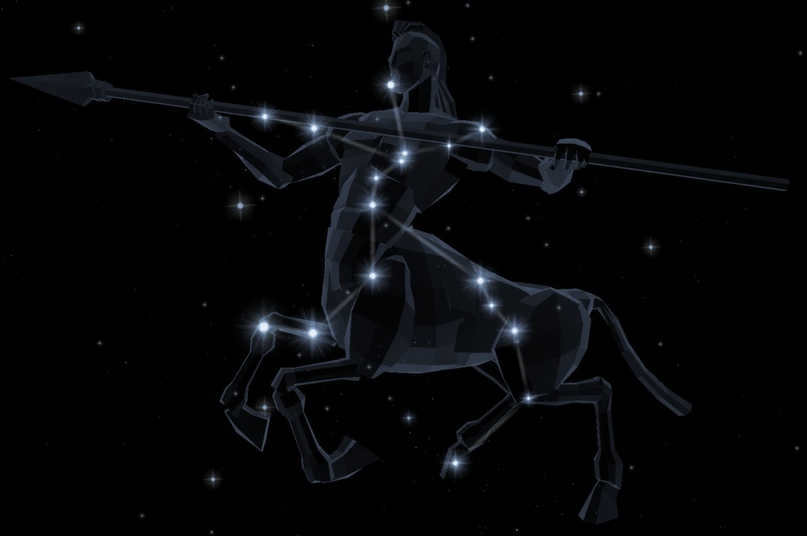
In contemporary astronomy, constellations are defined as distinct regions of the celestial sphere that serve as navigational reference points.
However, in ancient times, the term “constellation” held a different meaning. Our ancestors referred to constellations as groupings of stars in the sky that formed unique shapes and memorable figures. This approach to the study of stars and astronomy in general was not considered ideal, as the same star would often be part of different constellations, and certain stars would be overlooked.
In the early 1900s, the International Astronomical Union (IAU) devised an innovative method of celestial cartography, utilizing a traditional approach to partition the sky into distinct regions for the purpose of studying and identifying constellations. The IAU officially recognized a total of 88 constellations. However, in the Russian Federation, only 54 constellations are visible. Presented here are the top 10 renowned constellations that grace the celestial sphere.
10. Dragon
The mythical creature known as a dragon is a popular figure in many cultures around the world. It is often portrayed as a large, winged reptile with the ability to breathe fire. In some stories, dragons are depicted as evil and dangerous creatures that hoard treasure and terrorize villages. In others, they are seen as wise and noble beings, sometimes even capable of human speech. Regardless of their portrayal, dragons have captured the imagination of people for centuries and continue to be a popular subject in literature, art, and entertainment.
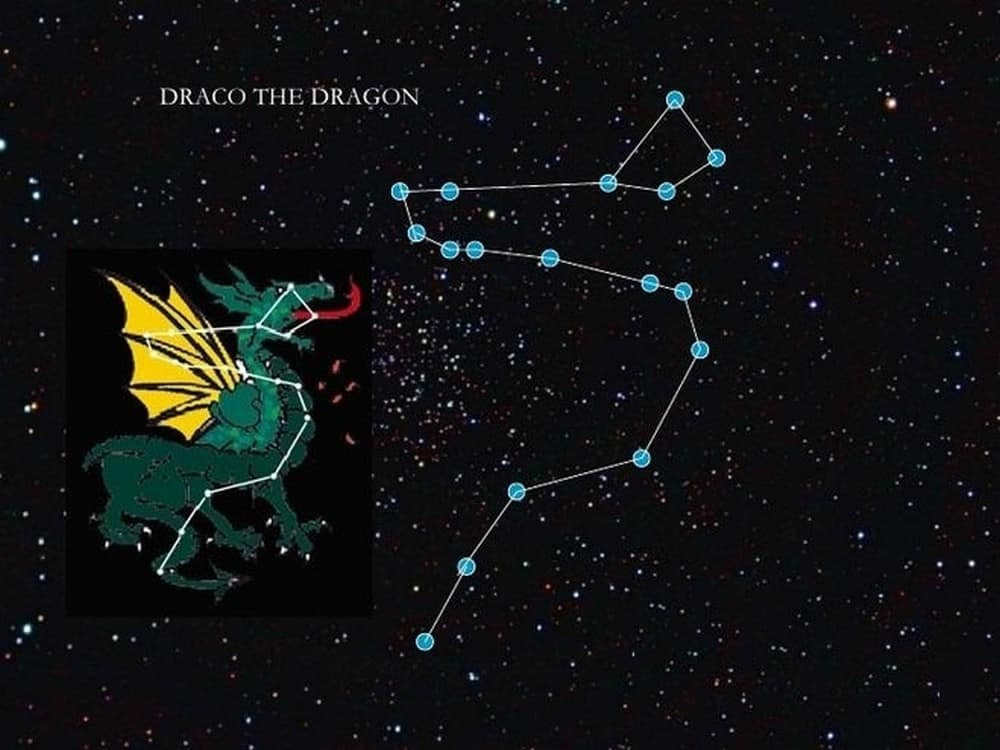
The constellation known as Dragon is not easily visible in the sky to everyone, which is not surprising given its vast size. It is one of the largest constellations, covering an area of 1083 square degrees. Spotting it requires effort from an inexperienced observer.
Dragon is situated in the Northern Hemisphere, close to the Arctic Circle, positioned between the Big and Little Bears. It consists of 80 stars, which emit a faint glow.
For the best chance of seeing Dragon, summer and fall, starting in May, are the recommended seasons. To locate it, one should use the Big Dipper as a guide. Nearby, a curved line of stars can be seen, forming an irregular rhombus that resembles a ladle – this is the head of the Dragon.
According to Greek mythology, the Titanomachy is connected to this particular constellation. During the intense fighting, Athena’s adversary hurled a massive serpent towards her, however, she managed to seize it by its tail and hurled it into the heavens. As a result, the serpent froze in the firmament, creating a constellation.
9. Cepheus
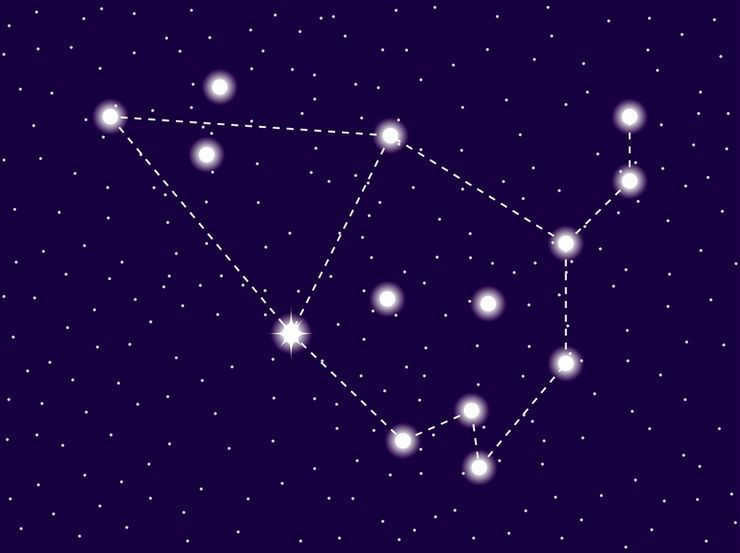
Cepheus can be found in the Northern Hemisphere of our planet. This particular constellation is smaller in size compared to Draco and covers only an area of 588 square degrees. It consists of 148 stars that can be observed without any special equipment. The nearest constellation to Cepheus is Ursa Minor, which is easily identifiable in the night sky, even by young children.
The shape of Cepheus resembles an irregular pentagonal figure. It contains a number of dim stars, which, nonetheless, can be seen throughout the year within the borders of the Russian Federation.
Within the scientific and astronomical community, Cepheus is renowned as a constellation that will eventually become the new home for the North Pole. However, this transition is a lengthy process that will not occur for at least another thousand years.
Traditionally, the constellation is associated with the ancient Greek king Cepheus, but modern-day scientists argue that this belief is a misconception, as the constellation itself emerged long after the king’s reign.

The constellation Centaurus is visible exclusively from the southern hemisphere of the planet, leaving the residents of the northern hemisphere without the opportunity to witness its beauty. Spanning a vast area of approximately 1060 sq. deg. in the celestial sphere, this constellation is comprised of 11 stars. To locate Centaurus, one must look along a straight line connecting the Big Dipper and Virgo.
In Russia, only a portion of the constellation can be seen, but only if the observer is situated in the southern regions of the country. To fully appreciate the splendor of Centaurus, travel to countries within the Southern Hemisphere is necessary.
7. Virgo
Virgo is the seventh astrological sign in the zodiac. It is represented by the symbol of the Virgin, which is often associated with purity and innocence. People born under this sign are known for their analytical and practical nature. They are often perfectionists and pay great attention to detail. Virgos are also known for their intelligence and strong work ethic. They are reliable and hardworking, always striving for excellence in everything they do. However, Virgos can also be critical and judgmental, both of themselves and others. They have high standards and expect the same from those around them. Despite their critical nature, Virgos are also loyal and caring friends. They are known for their willingness to help others and their ability to offer practical advice. In love, Virgos are often reserved and cautious. They value stability and practicality in relationships and may take their time before fully committing. Overall, Virgos are known for their practicality, intelligence, and attention to detail.
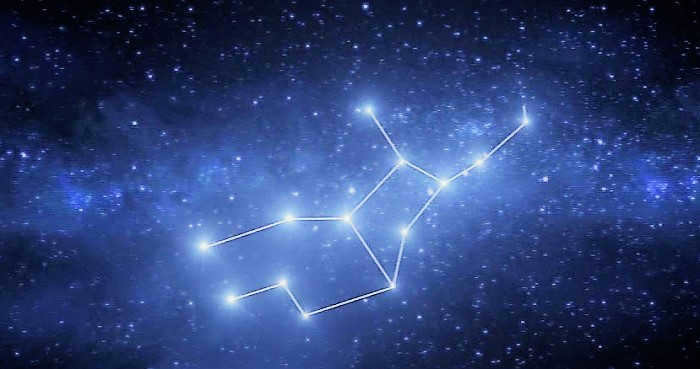
Virgo, one of the largest constellations in the night sky, covers about 1,294 square degrees and is situated between Leo and Libra near the equator. This constellation is associated with the fall equinox.
Traditionally, Virgo is depicted as a maiden holding a sheaf of wheat, but this is purely symbolic as the actual figure cannot be seen in the sky. To locate Virgo, one can look for the brightest star in the constellation, Spica. Without the aid of telescopes or binoculars, it is possible to observe a total of 171 stars that form Virgo.
According to ancient legends, Virgo represents the goddess of justice, Dica, who chose to ascend to the heavens rather than remain on Earth with unworthy individuals.
6. Hydra
Hydra is a mythical creature in Greek mythology. It is a multi-headed serpent-like monster with regenerative abilities. According to legends, whenever one of its heads was cut off, two more would grow in its place. The Hydra is said to have terrorized the area surrounding the lake of Lerna in ancient Greece. It was eventually killed by the hero Heracles as one of his twelve labors.
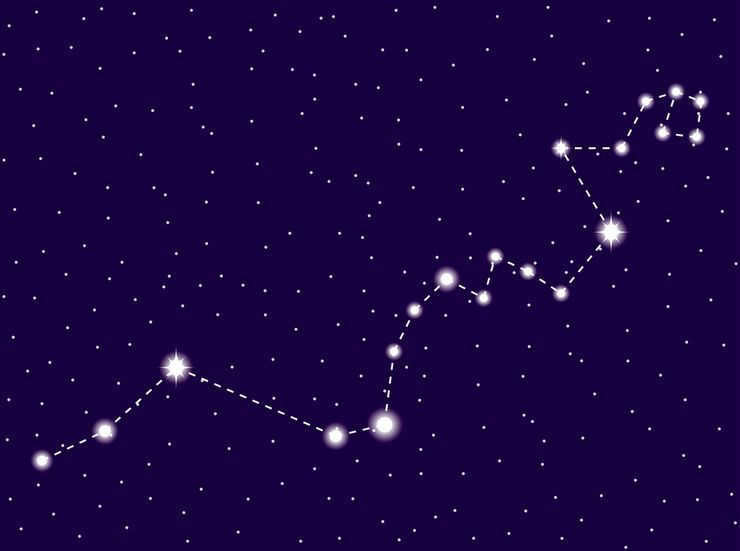
The largest known constellation can be observed in the southern part of the Earth. It goes by the name of Hydra and covers an area of 1300 square degrees in the sky.
In Russia, residents can catch a complete view of Hydra only from the southernmost regions of the country. The most favorable period for observations is towards the end of winter and during the spring months. Despite not being particularly bright, Hydra’s 229 stars can still be seen with the naked eye.
There is another story that tells of Hydra, a creature with seven heads, that was vanquished by Heracles.
5. Cassiopeia
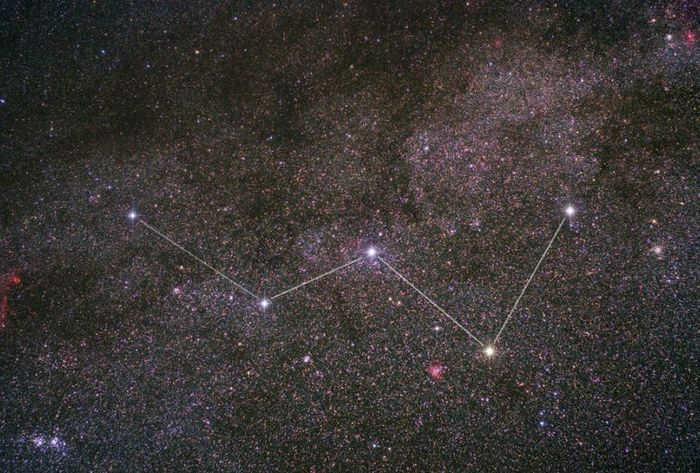
The constellation Cassiopeia can be observed in the night sky during the autumn season by those living in the Northern Hemisphere. It is characterized by its resemblance to the letter W in the English alphabet and occupies a relatively small area of the starry sky, covering 598 square degrees. Cassiopeia comprises 90 stars that are visible to the naked eye, with the outline of the constellation defined by its five brightest stars.
Named after Cepheus’ wife, Cassiopeia is said to have been a boastful character in ancient legends, and she paid the price for her arrogance. In punishment, she was bound to a royal throne that continuously rotated around the celestial pole. Every 24 hours, Cassiopeia would be inverted, turning her into a head-down position.
4. Pegasus
Pegasus is the name of a mythical winged horse in Greek mythology. It is often depicted as a white horse with wings sprouting from its back. According to legend, Pegasus was born from the blood of the Gorgon Medusa when she was beheaded by the hero Perseus. Pegasus was considered a divine creature and was associated with thunder and lightning.
In Greek mythology, Pegasus is best known for his association with the hero Bellerophon. Bellerophon captured and tamed Pegasus with the help of the goddess Athena. Together, they embarked on many adventures and defeated various monsters, including the Chimera.
Pegasus is often seen as a symbol of inspiration and poetry. He is often depicted as a muse, inspiring artists and writers to create masterpieces. Pegasus also has a place in astronomy, as a constellation named after him.
Overall, Pegasus is a fascinating creature from Greek mythology with a rich and storied history. Its iconic image and symbolism continue to captivate and inspire people to this day.
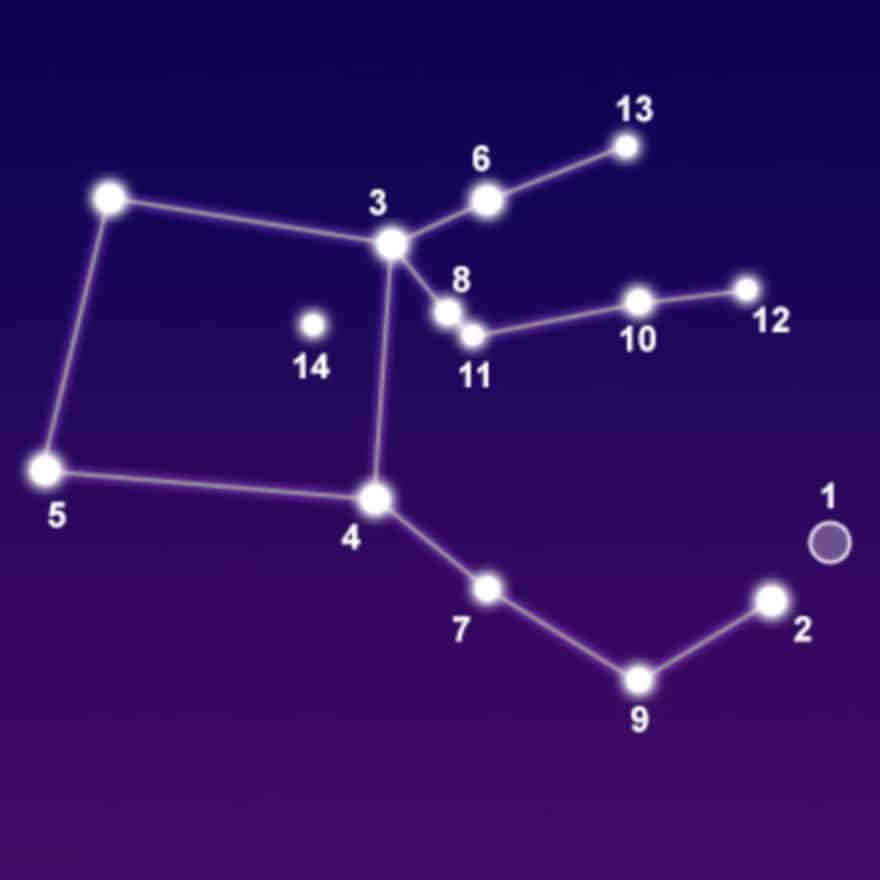
Pegasus is another expansive constellation located in the northern hemisphere. Covering an area of more than 1120 square degrees in the sky, it is comprised of 166 stars that are most visible during the late summer and early autumn.
In order to observe Pegasus in the celestial sphere, one must possess a vivid imagination, as its shape bears little resemblance to a horse. Instead, it takes the form of a quadrangle with extensions, adorned with a sprinkling of small stars.
According to ancient tales, Pegasus emerged from the blood that flowed from the severed head of the beastly Medusa Gorgon.
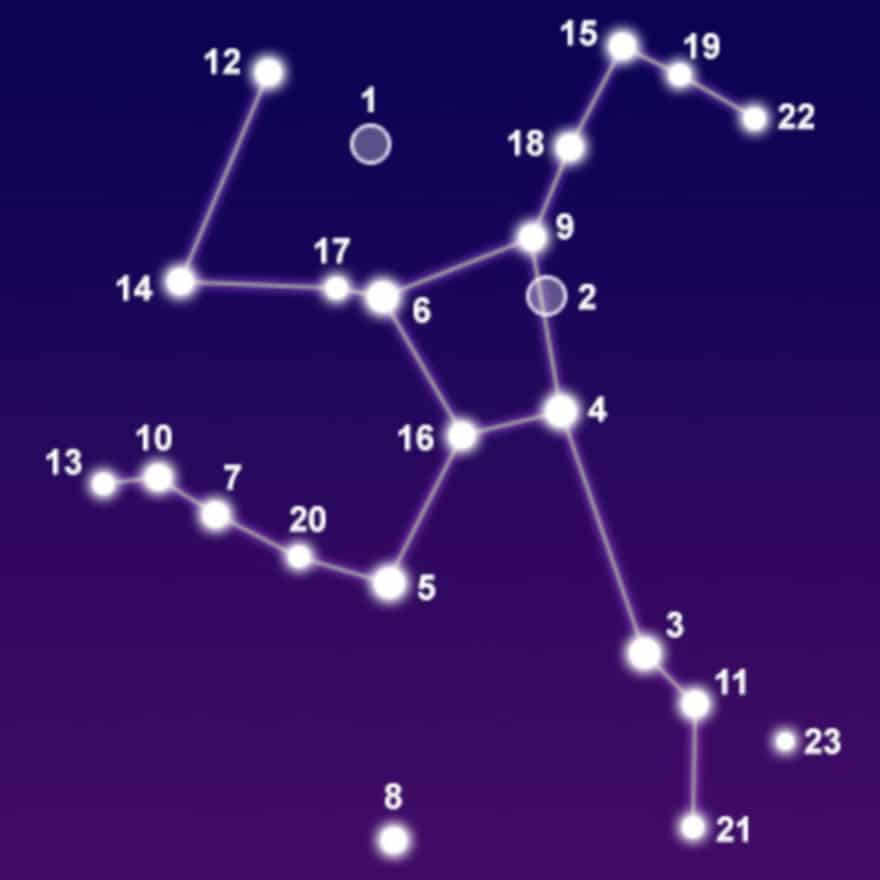
Ranked third among the most well-known constellations is Hercules. It can be observed in the northern hemisphere of Earth, with the most optimal viewing time being in June.
Hercules is classified as one of the largest constellations, covering an estimated area of 1225 square light years. The outline of the constellation is fully visible in Russia and is easily recognizable. Hercules is represented by a trapezoid shape, symbolizing the demigod’s torso, along with four branches representing his arms and legs.
The original name of this constellation is Knee-kneeling, and in ancient poetry, it was described as a suffering husband, without any explanation as to why. However, starting from the 5th century B.C., the constellation came to be known as Hercules.
2. Ursa Major
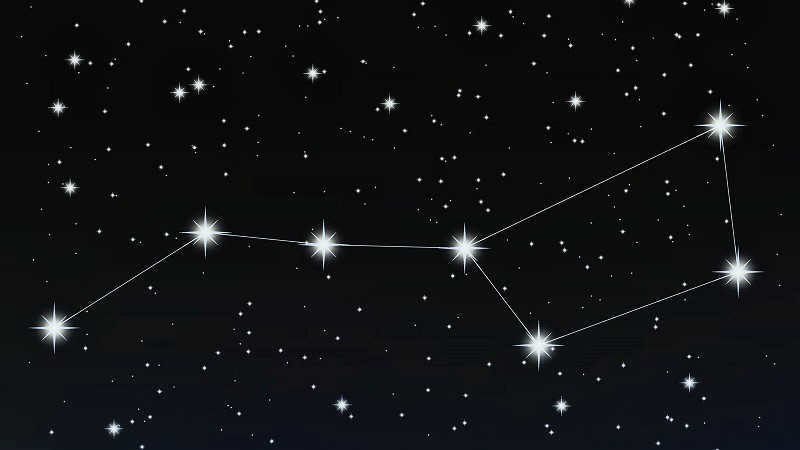
The second position in the ranking is occupied by the well-loved Big Dipper. It can be easily spotted in the night sky of the northern hemisphere. Even children can recognize this famous constellation. The Big Dipper covers an area of 1280 square degrees and consists of 125 stars that are visible to the naked eye.
The Big Dipper is the most well-known asterism within the constellation, although it also goes by other names such as the Plow or the Moose.
The Big Dipper has a fascinating legend associated with it, in which Zeus attempts to protect his beloved Callisto from the wrath of Hera by transforming her into a bear.
1. The Tiny Bear
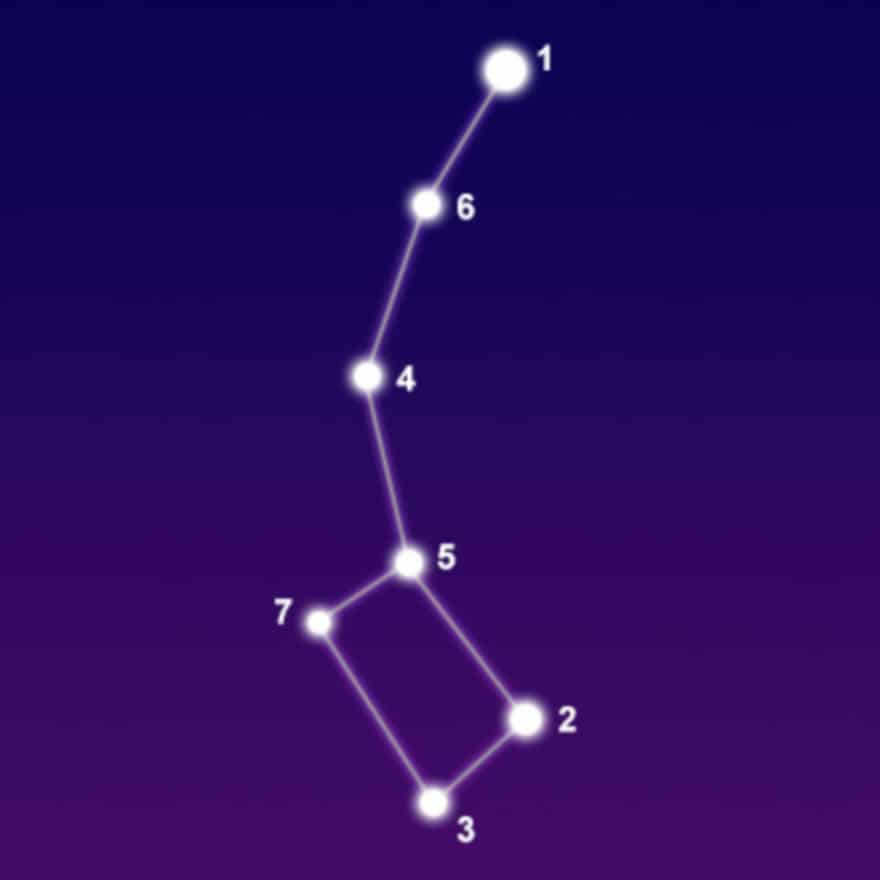
The Little Bear resides adjacent to the Big Dipper. This star formation can be observed throughout the year in the Northern Hemisphere and is known for its proximity to the celestial pole.
Renowned features of this constellation include the Small Container and the Protectors of the Axis. According to mythology, the Little Dipper represents the faithful canine companion of Callisto. In order to grant them everlasting existence, Zeus metamorphosed both Callisto and her lover into bears, placing them in the heavens above.
Atlas-determiner “From the Earth to the Sky”. Learning to recognize stars and constellations.
Pleshakov came up with a brilliant concept – developing an atlas specifically designed for children, enabling them to easily identify stars and constellations. Our educators embraced this idea and crafted their own definitive atlas, which is not only more comprehensive but also more user-friendly.
What do constellations represent?
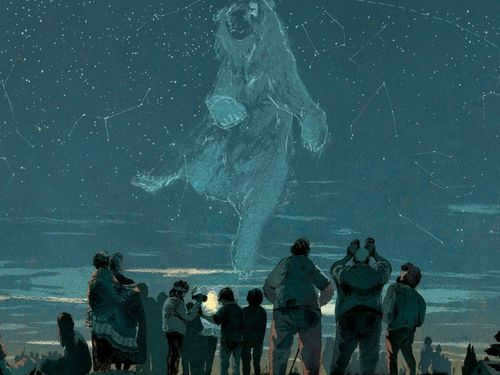
If you gaze up at the heavens on a cloudless evening, you will witness a multitude of shimmering, assorted luminaries adorning the firmament akin to a sprinkling of precious gems. These luminaries are known as celestial bodies. Some of them appear to be clustered together and with a prolonged inspection, they can be categorized into specific assemblages. These assemblages are referred to as “constellations” by humans. Certain constellations may bear a resemblance to the shape of a vessel or the intricate contours of animals, but, to a large extent, this is merely a product of the imagination.
For centuries, astronomers have endeavored to study these star clusters, attributing them with mystical qualities. They sought to classify and identify common patterns among them, thus giving rise to constellations. Over time, constellations were meticulously examined, with some being further divided into smaller constellations or modified. For instance, the constellation Argo was subdivided into Compass, Kiel, Sail, and Corma.
The history behind the names of constellations is equally fascinating. In order to aid memorization, constellations were given names that shared a common element or were inspired by literary works. For example, certain constellations were associated with heavy rainfall periods, leading to the names Capricorn, Whale, Aquarius, and the constellation of Pisces.
In 1930, during the meeting of the International Astronomical Union, a decision was made to officially register 88 constellations in order to classify all constellations. The accepted solution stated that constellations are not formed by groups of stars, but rather are specific sections of the starry sky.
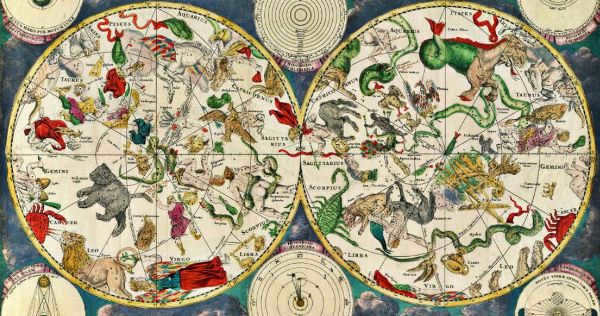
Constellations vary in terms of the number and luminosity of the stars that comprise them. There are 30 notable clusters of stars that are distinguished. The Big Dipper is regarded as the largest constellation in terms of its area. It is comprised of 7 bright stars and 118 stars that can be seen without the aid of a telescope.
The smallest constellation, known as the Southern Cross, is located in the southern hemisphere and is not visible to the naked eye. It is composed of 5 bright stars and 25 stars that are less visible.
The Lesser Horse is the smallest constellation in the northern hemisphere and consists of 10 dim stars that can be seen without the aid of a telescope.
The constellation Orion is considered to be the most stunning and brightest. It is composed of 120 stars that can be seen without the aid of a telescope, with 7 of them being exceptionally bright.
Constellations are categorized into those found in the southern or northern hemisphere. Individuals residing in the southern hemisphere are unable to observe star clusters located in the northern hemisphere, and vice versa. Out of the 88 constellations, 48 are situated in the southern hemisphere, while 31 are found in the northern hemisphere. The remaining 9 star clusters are situated in both hemispheres. The northern hemisphere can be easily distinguished by Polaris, which consistently emits a brilliant glow in the sky. It is the outermost star on the handle of the Big Dipper.
Because of the Earth’s orbit around the Sun, certain constellations are not visible at all times due to the changing seasons and the position of the Sun in the sky. During winter, the Earth is on the opposite side of its solar orbit compared to summer. As a result, only specific constellations can be seen during each season. For instance, during summer nights, one can observe a triangle shape formed by the stars Altair, Vega, and Deneb. On the other hand, winter nights provide the opportunity to marvel at the endlessly beautiful constellation Orion. This is why some people refer to constellations as fall constellations, winter constellations, summer constellations, or spring constellations.
The best time to view the constellations is during the summer season, and it is recommended to observe them outdoors, away from urban areas. Certain stars are visible to the naked eye, while others may require the use of a telescope. The most prominent constellations to observe include the Great and Little Bear, as well as Cassiopeia. During the autumn and winter months, Taurus and Orion are the constellations that can be observed most clearly.
Among the constellations that can be seen in Russia, some of the most stunning ones in the northern hemisphere include Orion, Ursa Major, Taurus, Canis Major, and Canis Minor.
If you observe their positioning and let your imagination roam freely, you may perceive a scene of hunting, reminiscent of an ancient fresco that has adorned the sky for over two millennia. The courageous hunter Orion is always portrayed surrounded by animals. Taurus charges towards his right side while the hunter wields his club against him. At Orion’s feet, you can find the faithful companions, the Great and Little Dogs.
The Orion constellation
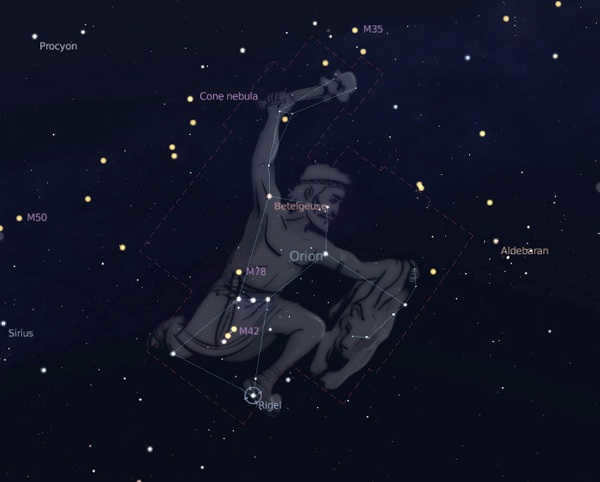
Orion is the largest and most vibrant constellation, easily visible during the fall and winter seasons. It can be observed across the entire territory of Russia. The arrangement of its stars resembles the silhouette of a human figure.
The origins of this constellation can be traced back to ancient Greek mythology. According to the stories, Orion was a courageous and mighty hunter, the son of Poseidon and the nymph Emvriala. He frequently hunted alongside Artemis, but one day, after defeating her in a hunt, he was struck by the goddess’s arrow and perished. Following his demise, he was transformed into a constellation.
Betelgeuse adorns the shoulder on the right side of Orion. With a diameter 450 times that of the Sun, if it were to replace our solar luminary, Betelgeuse would easily take up the space of the four planets, extending all the way to Mars. Additionally, Betelgeuse illuminates the sky with a brilliance 14,000 times greater than that of the Sun.
The Orion constellation is not only home to Betelgeuse, but also boasts a beautiful nebula and various asterisms.
The constellation Taurus
Taurus is a vast and incredibly stunning constellation found in the northern hemisphere. It can be seen in the northwest of Orion and is situated between Aries and Gemini. Other nearby constellations include Ascendant, Whale, Perseus, and Eridanus.
This constellation is visible throughout most of the year in middle latitudes, excluding the latter half of spring and early summer.
The origins of Taurus can be traced back to ancient myths, which tell the story of Zeus transforming into a calf to abduct the goddess Europa and bring her to the island of Crete. The mathematician Eudoxus was the first to describe this constellation, living long before our era.
Aldebaran is not only the brightest star in this constellation, but also in the other 12 groups of stars. It is situated on the head of Taurus and was previously known as “the eye”. Aldebaran has a diameter 38 times larger than the Sun and is 150 times brighter. This star is located 62 light years away from us.
The second most luminous star in the constellation is Nat or El-Nat (the bull’s horns). It can be found near Ascendant. Nat is 700 times brighter than the Sun and 4.5 times larger.
Within the constellation, there are two incredibly stunning dispersed star clusters: the Hyades and the Pleiades.
The Hyades are approximately 650 million years old. They can be easily spotted in the night sky, thanks to Aldebaran, which is perfectly visible among them. The Hyades consist of approximately 200 stars.
The Pleiades earned their name because they consist of nine components. The seven sisters of ancient Greece (the Pleiades) are the namesakes of seven of these components, while the remaining two are named after their parents. The Pleiades are particularly prominent during the winter months and encompass approximately 1000 celestial bodies.
Another fascinating celestial formation within the Taurus constellation is the Crab Nebula. This nebula originated from a supernova explosion in 1054 and was first observed in 1731. Located 6,500 light years away from Earth, the nebula boasts a diameter of approximately 11 sv. years.
This star formation is a member of the Orion group and is bordered by the Orion, Unicorn, Canis Minor, and Lepus constellations.
The Big Dog constellation was initially identified by Ptolemy during the second century.
According to legend, the Big Dog was once known as Lelap, an exceptionally swift hound capable of catching any prey. On one occasion, Lelap pursued a fox that proved to be just as fast. The outcome of their race was predetermined, and Zeus transformed both creatures into stone, placing the dog among the stars.
The Big Dog constellation is highly visible during the winter months. Sirius, the brightest star not only in this constellation but also in all other constellations, has a bluish glow and is located relatively close to Earth, at a distance of 8.6 light years. Although it is outshone by Jupiter, Venus, and the Moon in our solar system, the light from Sirius takes 9 years to reach Earth and is 24 times stronger than the light from the sun. Interestingly, Sirius has a companion known as Puppy.
Sirius is closely associated with the origin of the term “Vacation”. This is because this star would appear in the sky during the summer heat. Since the Greek word for Sirius is “kanis”, the Greeks began referring to this period as “kanis vacation”.
The constellation Canis Minor
The Canis Minor constellation is surrounded by neighboring constellations such as Unicorn, Hydra, Cancer, and Gemini. It symbolizes the animal that, together with the Canis Major, trails behind the hunter Orion.
The tale behind the formation of this constellation is quite fascinating, as per the mythical accounts. According to the legends, Canis Minor is Mera, the faithful dog of Icarius. This man was taught the art of winemaking by Dionysus, and his wine was exceptionally potent. One fateful day, Icarius’ guests mistakenly believed that he intended to poison them and tragically ended his life. Mera, grief-stricken by the loss of his master, soon perished as well. Zeus, in his benevolence, immortalized Mera by transforming him into a constellation in the celestial sphere.
The best time to observe this constellation is during the months of January and February.
The two most prominent stars within this constellation are Portion and Gomeisa. Portion is located approximately 11.4 light-years distant from our planet Earth. Although it shines with a slightly greater intensity and possesses a higher temperature than our Sun, it is remarkably similar to it in terms of physical characteristics.
Gomeisa, on the other hand, can be easily observed without the aid of any optical instruments and emits a radiant blue-white glow.
The star formation known as the Big Dipper
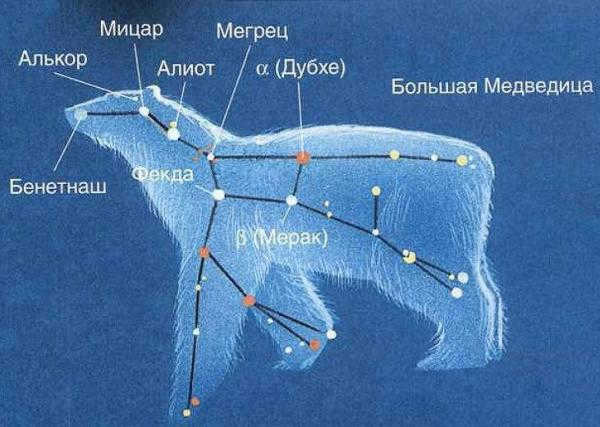
The Big Dipper, resembling a ladle, is among the largest constellations, and it is mentioned in the works of Homer and in the Bible. This constellation has been extensively researched and holds significant religious importance.
It is bordered by constellations such as Aquarius, Leo, Leo Minor, Canes Venatici, Draco, and Lynx.
According to Greek mythology, the Big Dipper is associated with Callisto, a beautiful nymph and lover of Zeus. As punishment, Zeus’ wife Hera transformed Callisto into a bear. One day, this bear encountered Hera and her son Arcas, who was also Zeus’ child, in the forest. To prevent tragedy, Zeus transformed both the son and the nymph into constellations.
The Big Dipper is composed of seven stars, with the three brightest being Dubhe, Alkaid, and Alioth.
Dubhe is a red giant star that points towards Polaris and is located 120 light years away from Earth.
Alkaid, the third most luminous star in the constellation, marks the termination of the tail of the Big Dipper. It is situated approximately 100 light-years distant from Earth.
Aliot, on the other hand, is the most brilliant star in the constellation, symbolizing the tail. Due to its remarkable luminosity, it serves as a navigational guide. Aliot outshines the Sun by a factor of 108.
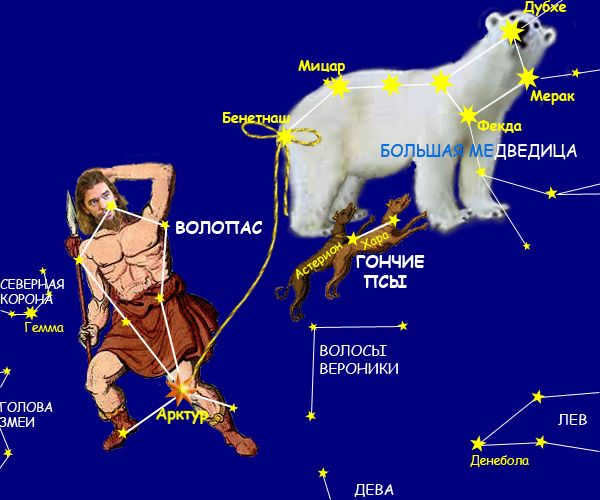
These constellations are the most brilliant and stunning constellations in the northern hemisphere. They can be easily observed with the naked eye on a crisp autumn or winter night. The stories behind their formation allow for endless imagination, envisioning the powerful hunter Orion chasing his prey with his loyal dogs by his side, while Taurus and the Big Dipper keenly observe his every move.
Russia is situated in the northern hemisphere, and in this part of the sky, we can only witness a fraction of the vast number of constellations that grace the heavens. Their positions in the sky may change depending on the time of the year.
Feedback
There are a few inaccuracies in the data provided. For instance, the Southern Cross constellation is actually visible to the naked eye, even in the northern hemisphere where it can be seen low on the horizon. It’s important to ensure that the information is correct and reliable.
There are countless wonders in the world that are worth marveling at, such as the mesmerizing starry sky. It is both enigmatic and magnificent. The study of stars dates back to the 6th millennium B.C., when they were first observed and categorized. A constellation represents not only a group of stars, but also a portion of the celestial sphere. But have you ever wondered where these stars come from? There are various legends that shed light on this intriguing mystery.
The origin of stars
Many stars, especially those that are bright and captivating, have been bestowed with names. However, to this day, scientists remain uncertain about their true origins. According to a popular legend, stars are believed to be the eyes of adventurous boys who managed to escape to the heavens. It is said that these boys captured a bird and commanded it to fasten a sturdy liana to the mightiest tree in the celestial realm. Once the bird had completed its task, the boys began their ascent, climbing higher and higher. Unbeknownst to them, their concerned mothers noticed their audacious endeavor and pleaded with them to return to safety. Unfortunately, the boys turned a deaf ear to their mothers’ pleas. Desperate to bring their sons back, the mothers too started climbing the liana, determined to reach the heavens. It was when the last boy finally reached the heavenly realm that he severed the vines, causing the mothers to fall back to earth and transform into animals. As punishment for their recklessness, the boys were condemned to forever watch over the world from the sky, their actions illuminated as stars twinkling in the night sky. And so, the stars became their eternal eyes, a constant reminder of their mischievous deeds.

When it comes to scientific hypotheses, they connect the origin of stars with the compression of gas-dust condensations in molecular clouds. However, the source of these clumps in molecular clouds and the reason for their contraction remain unexplained by scientists. Opinions on this matter are divided. Some researchers propose that the magnetic field within the molecular clouds prevents them from shrinking. According to this theory, clots form in areas where the magnetic field weakens, giving rise to pre-stellar nuclei. On the other hand, opponents of this view argue that pre-stellar nuclei are the result of chaotic collisions between matter flows. Both theories lack sufficient evidence, making it impossible to determine the true cause of star formation.
Constellations are a truly breathtaking sight
As previously mentioned, a constellation refers to a specific group of stars. Currently, scientists acknowledge the existence of 88 such groupings. While we won’t delve into each one, we will concentrate on the most renowned ones. Let’s delve into the appearance of constellations, whose names are familiar to all. Many of us have frequently heard and even employed these names in our conversations, yet not everyone has been able to locate these star clusters on the celestial map. This is not surprising since the night sky is filled with countless shimmering points, making it challenging to connect them into a specific shape. Constellations vary in shape, the number of stars they encompass, size, and age. Each likely possesses its own unique tale. The names of the stars and constellations we will explore are often intertwined with legends and folklore. We will present a few of them shortly, but first, let’s delve into a bit more theory.
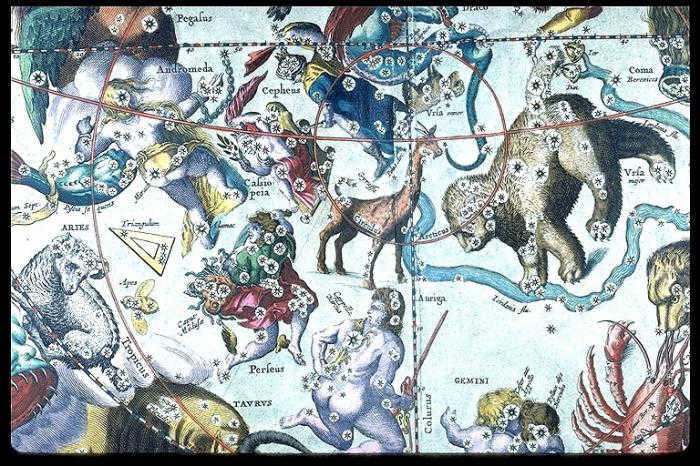
Types of Constellations
Constellations can be divided into two categories: large constellations and small constellations. Some examples of large constellations are the Big Dipper, Hercules, Pegasus, Aquarius, Volopassus, and Andromeda. On the other hand, the Southern Cross, the Chameleon, the Flying Fish, the Small Dog, and the Bird of Paradise are examples of small constellations. It is important to note that these are just a few of the many constellations that exist.
There are certain celestial compasses that can be observed throughout the entire year, while others can only be seen during specific periods. For instance, Hydra, Leo, and the Big Dipper are prominently visible in April. Therefore, the question of when to observe the constellations can only be accurately answered by saying: every night. Additionally, there are certain star clusters that cannot be seen at all. The constellations of the Southern Hemisphere, for example, are not always visible to those residing in northern latitudes. However, the same Lion constellation can be found in the Northern Hemisphere during spring and in the Southern Hemisphere during fall.
The arrangement of stars in the Big Dipper constellation
The well-known Big Dipper constellation, easily identifiable even by children, takes the form of a bucket. However, this shape is merely an illusion. Surprisingly, the Big Dipper is composed of a staggering 125 stars, a fact that is not widely known. The name “Big Dipper” was given to this constellation due to its distinctive shape. According to ancient mythology, Zeus himself is credited with placing this constellation in the sky.
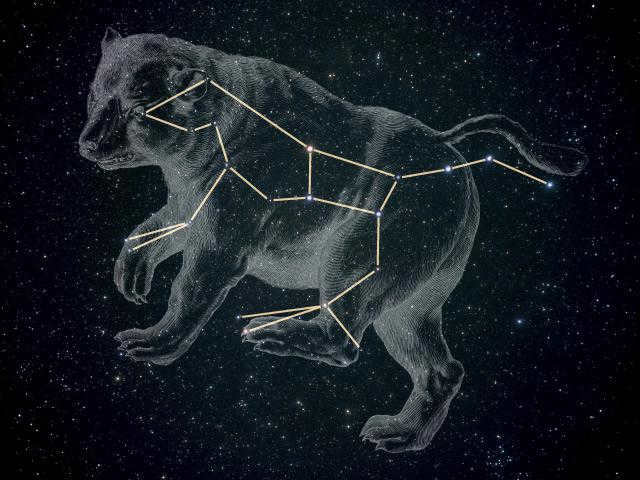
The mighty god of thunder once had deep feelings for the exquisite Callisto. However, this caused great distress to Zeus’ spouse. As an act of vengeance, she transformed her love rival into a majestic bear, which was almost slain by her own son, the skilled hunter Arkas, upon his return home and encounter with the ferocious creature. Yet, Zeus himself intervened to prevent such tragedy. He elevated Callisto to the heavens alongside Arkas and their loyal canine companion. Now, the son must dutifully protect his mother in the celestial realm. Arkas was transformed into the constellation Volopas, while his faithful dog became known as the Little Dipper. Truly, this captivating tale never fails to intrigue.
The Little Dipper constellation is located 70 light years away from Earth. There are 7 main stars that can be easily seen with the naked eye. These stars are known as Dubhe, Merak, Fekda, Megrez, Aliot, Mitsar, and Benetnash. Together, they form a shape resembling a bucket, which is clearly visible in the night sky. All of these stars, except for Dubhe, are classified as hot white giants. Dubhe, on the other hand, is an orange giant star.
Adjacent to the Big Dipper is the Little Dipper constellation. The highlight of this constellation is the presence of Polaris, the most well-known star in the entire sky. Polaris is a supergiant star. In addition to Polaris, the Little Dipper constellation also includes Cohab, Ferhad, Delta, Epsilon, Zeta, and Etu of the Little Bear.
Orion
can be paraphrased as
The Hunter
.
One of the largest and most fascinating treasures of the celestial sphere is the constellation Orion. According to the legend, this constellation represents the hunter Orion, who once ventured into the forests of Cypheron. On a scorching hot day, Orion’s sole focus was finding a stream with cool water to quench his thirst. Eventually, he discovered a pristine stream and nearby, a magnificent cave enveloped in lush greenery. As Orion approached, he spotted Artemis, the goddess of the hunt, resting there with her nymphs. Artemis had intended to bathe in the lake, but her nymphs, upon seeing Orion, exclaimed in alarm before shielding their mistress from the mortal’s gaze. This infuriated Artemis, causing her to transform Orion into a deer while leaving him with his human consciousness. The hunter fled, pursued by his loyal hounds. Orion desperately wanted to communicate to them that he was their master, but how could a deer speak? The hounds eventually caught up with him and tore him to pieces. However, the gods took pity on the unfortunate man and immortalized him as the constellation Orion in the night sky, never forgetting his faithful hounds.
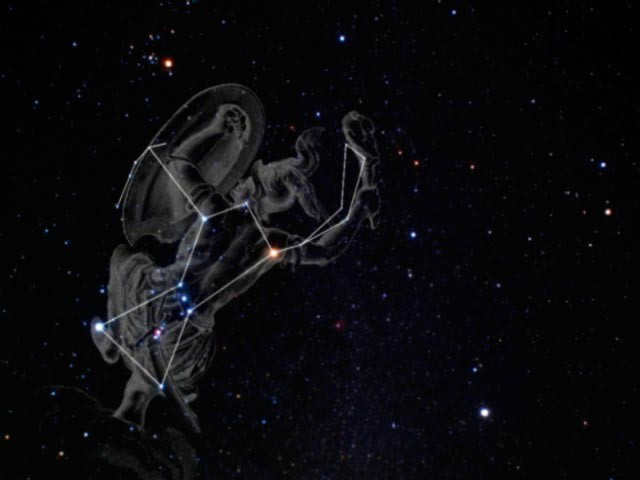
The Canis Major Constellation
The presence of this constellation in the celestial sphere is linked to the myth of Orion. As this formidable hunter had a fondness for two loyal canines, the constellations that adorn the night sky are also two – Canis Major and Canis Minor. Let us briefly explore each of them.
The Canis Minor constellation is relatively diminutive in size. It is embellished with the prominent star known as Procyon. Due to its proximity to the Sun, this star shines conspicuously in the firmament. Procyon is characterized as a yellowish subgiant in terms of its physical properties.
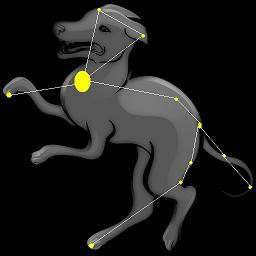
The Big Dog constellation can be found in the Southern Hemisphere. Its most notable feature is the blue-white Sirius star. Sirius is known for its ability to change color, ranging from blue to red, and is considered one of the largest and brightest stars within this constellation. In fact, it is often regarded as the most brilliant star in the night sky. Another stunning star in this constellation is the blue hot star Mirzam, which undergoes periodic changes in its brightness. This group of celestial objects is also home to numerous galaxies and nebulae. The Dog constellation is particularly prominent in the skies of Montenegro.
The Swan’s presence in the celestial sphere is attributed to the all-powerful Zeus. As the legend goes, the supreme god of ancient Greece once laid eyes on the stunning Leda, who happened to be the spouse of Tindareus, the king of Sparta. However, such matters held no significance in Zeus’ eyes. He was so captivated by Leda’s beauty that he resolved to make her his beloved, all the while harboring apprehensions about his wife, Hera, and her potential jealousy. Consequently, the thunderous deity assumed the form of a white swan in order to rendezvous with the enchanting Leda. In due course, Leda gave birth to a son and a daughter. The deities immortalized the swan’s image in the heavens, serving as a symbol of Zeus and Leda’s love.
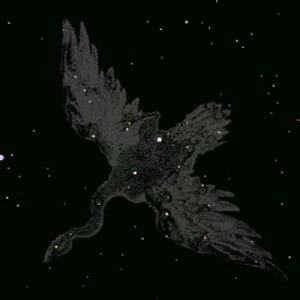
The constellation situated in the northern hemisphere is also known as the Northern Cross. It can be located near Cepheus. Notable stars within this constellation include Deneb, Sadr, and Albireo.
Leo
According to the legends surrounding the constellations, the Nemean Lion serves as the original model for the celestial Lion. This creature once instilled fear and terror into the hearts of people. In order to rid themselves of this menace, King Eurystheus sought the assistance of Hercules. Without hesitation, Hercules set out to find the Nemean Lion. He spent an entire day scouring the land for the fearsome beast, but his efforts proved fruitless. As night descended, the lion betrayed his presence with a bone-chilling roar. It didn’t take long for the hero to locate the monster’s den. Upon closer inspection, he discovered two exits from the cave where the Nemean Lion resided. Hercules sealed off one of the exits with rocks and concealed himself near the other. When the creature emerged, Hercules unleashed a barrage of arrows from his bow. Yet, to his astonishment, each arrow bounced harmlessly off the monster’s impenetrable skin. Undeterred, the fearless hero lunged at the beast and strangled it. And so, thanks to Zeus, the Lion of Nemea was immortalized in the night sky as a testament to his son’s heroic deeds.
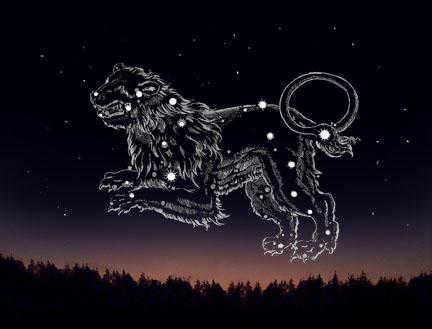
This constellation in the northern hemisphere bears a striking resemblance to a majestic lion with a luxuriant mane. If you’re interested in locating it on a celestial map, you can find it just below the hind legs of the prominent asterism known as the Big Dipper. Within this constellation, there are several stars that shine brightly. Among them, the most luminous is Regulus. Slightly less radiant are Denebola and Zosma.
Virgo
Virgo is the sixth astrological sign in the zodiac. It is ruled by the planet Mercury and is associated with the element of Earth. People born under the sign of Virgo are known for their attention to detail, practicality, and analytical thinking. They are often seen as meticulous and organized individuals who strive for perfection in everything they do. Virgos are also known for their intelligence and ability to solve problems quickly. They are often seen as reliable and hardworking individuals who excel in their chosen fields. Despite their practical nature, Virgos can also be quite sensitive and emotional. They value loyalty and honesty in their relationships and are deeply committed to those they care about. Overall, Virgos are known for their practicality, intelligence, and attention to detail, making them a valuable asset in any team or organization.
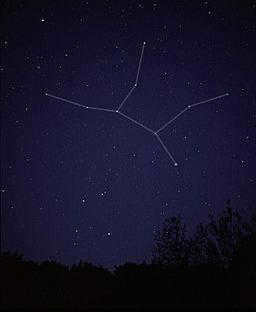
This particular constellation may not be among the most luminous ones. Nevertheless, it boasts a rather remarkable size. Situated to the left of Leo and beneath Volopassus, it takes on the shape of a curved quadrangle. The star that shines the brightest in Virgo goes by the name of Spica. The rest of the stars in this constellation pale in comparison to its brilliance. Notable among them are Porrima and Windemeatrix.
Serpentine
Like many other stars and constellations, Serpentine has its origins in ancient mythology. This constellation is a tribute to Asclepius, the son of Apollo and a renowned healer. According to the legend, Asclepius witnessed a snake delivering medicinal herbs to his friend, which allowed him to discover the secrets of healing and even revive the dead. Fearing that humanity would attain immortality, Zeus intervened and struck down Asclepius with a bolt of lightning. Nevertheless, the god granted him a place among the stars as a lasting tribute.
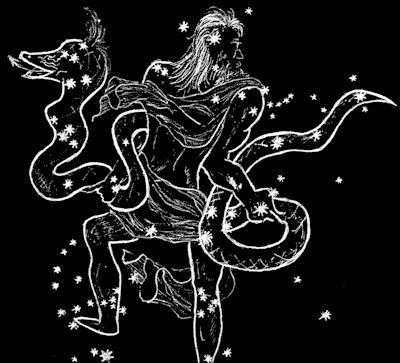
This particular constellation is of considerable size. Its visual representation is reminiscent of a shapeless polygon. Situated in close proximity to Hercules, Serpentine boasts a trio of luminous stars: Rasalhag, Cebalrai, and Sabik.
Pegasus, Cassiopeia, Cepheus, Andromeda and Perseus are constellations in the night sky.
Pegasus is a constellation with a square shape and it includes the star Alpheratz, which is the farthest star in the Andromeda constellation. In addition to Alpheratz, there are four other prominent stars in Pegasus. These stars are Markab, Sheath, Algenib, and Enif. As for the Andromeda constellation, it consists of three bright stars: Alpheratz, Mirach, and Almach.
Centauri
This constellation, known as Centauri, is located in the southern hemisphere. It is based on the mythological figure of Chiron, a centaur who was the son of the god Cronus and known for his wisdom and teaching abilities. Among his notable students were Achilles, Jason, and many others. Tragically, Chiron’s life came to an end when he was accidentally struck by an arrow shot by his friend Heracles, leading to his mortal wound. However, the gods, recognizing his great accomplishments, decided to honor him by immortalizing him in the night sky as a constellation.
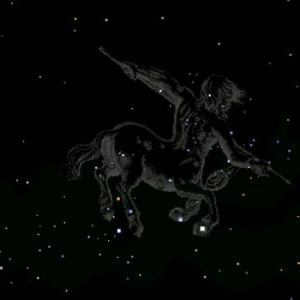
The starry sky never fails to captivate anyone who gazes upon it. Each constellation holds its own allure, veiled in mystery and beauty. These celestial formations carry their own unique histories and existences. Regrettably, our fascination with them is limited, resulting in a lack of knowledge regarding the enchanting legends associated with constellations. Irrespective of their size or brightness, every constellation possesses an undeniable beauty.
As children, we stare up at the night sky, attempting to identify the constellations that grace it. We are captivated by their names and the shapes they form with their stars, yet we often overlook the true definition of what a “constellation” truly is. Even as adults, we occasionally fail to comprehend the profound meaning concealed within this familiar term.
When a spaceship embarks on a journey through space, it will never reach any of the countless constellations that adorn our night sky. The reason for this is that although the stars appear to be on the same plane to us, they are actually scattered across vast distances. Each constellation is a unique projection of a specific section of the celestial sphere, showcasing the cosmic objects that reside within it.
A brief overview of the past
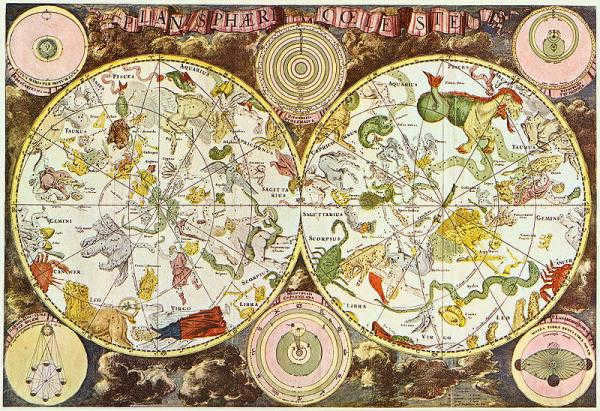
The concepts of constellations have varied throughout different time periods. Currently, there are 88 recognized celestial patterns, but this was not always the case. Ptolemy, in his renowned work “Almagest,” organized and named ancient constellations. His compilation consisted of 48 celestial figures, all of which, except for one, have maintained their names to this day. The expansive constellation Argo, representing the ship of the Argonauts, was later divided into three smaller constellations: Carina, Vela, and Puppis. The original descriptions of these celestial patterns, now referred to as ancient, were recorded by the Greek poet Aratus around 245 B.C.
In 1613, Peter Plancius created a number of fresh celestial illustrations on his globe, and in 1624, thanks to Jacob Bartsch, a German astronomer, physician, and mathematician, they started to gain popularity in the scientific community. Currently, only two of these drawings, the Giraffe and the Unicorn, have managed to survive on the star chart.

Final Arrangement
At this point in time, the list of constellations was not yet complete. In the 17th century, Jan Hevelius identified an additional seven star patterns (Sextant, Lesser Lion, Lizard, Shield, Lynx, Fox, Hound Dogs). Then, in the 18th century, Nicola Louis de Lacaille made further contributions by depicting 17 constellations that finalized the list.
However, the story of constellation names did not conclude there. Ancient celestial drawings attempted multiple times to rename the constellations, replacing the Greek gods and heroes with Christian saints. Occasionally, people wanted to experience the glory of the Olympians as rulers and commanders. Nevertheless, all of these efforts proved to be unsuccessful.
Borderlines
By the conclusion of the 18th century, the contemporary comprehension of constellations was ultimately established. The designations of the celestial figures were also more or less agreed upon. The only thing left was to define the borderlines.
Presently, constellations are not only understood as certain luminaries that form a recognizable outline. It encompasses the entire “territory” surrounding these stars. Constellations are separated by the borderlines, which were established in 1935 after extensive collaborative efforts by several renowned astronomers.
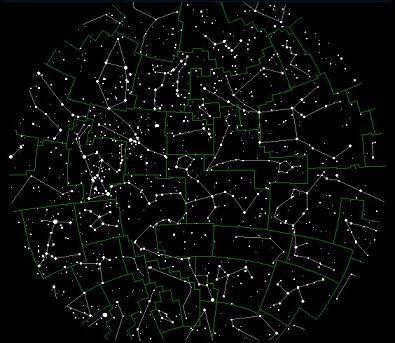
Uninterrupted movement
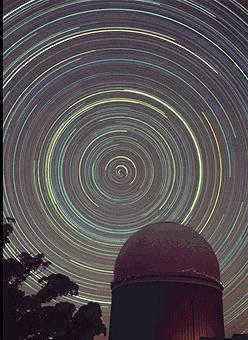
Within this scenario, there is a consistent bright point that consistently ascends and descends in a precise location, unlike the Sun and the Moon, which shift their rising and setting positions each day. The Moon and the Sun “journey” from one constellation to another, essentially “visiting” twelve celestial illustrations. The Sun travels its path throughout the year, while the Moon completes its journey in approximately 27 days. The welcoming “residences” that accommodate the Sun once every twelve months form the Zodiacal Circle.
Astrology’s Fundamental Principles
It is common knowledge that the zodiac signs are composed of constellations. What’s fascinating is that the specific celestial arrangement in which the Sun resides during a given month remains concealed from observers until six months later.
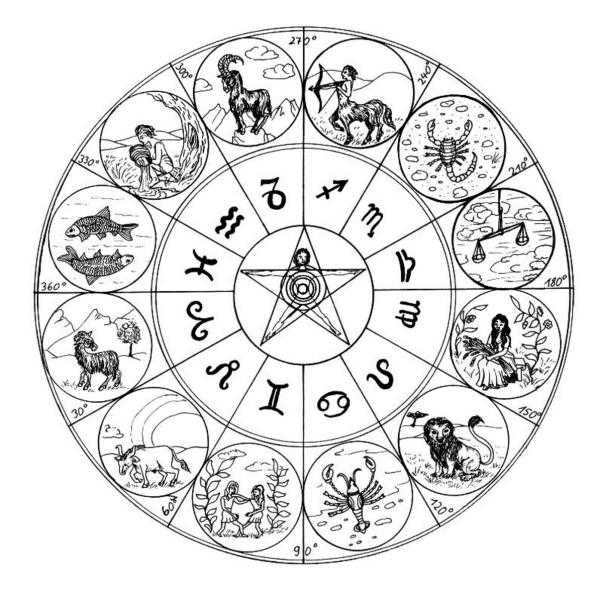
The constellations of the zodiac signs have been known to humanity for a considerable period of time. Some of their names have been heard since the Middle Ages, which is considered the birthplace of one of the earliest civilizations. The term “zodiac” itself originates from Greek, where “zodiakos” means “animal”. These twelve constellations were given such names due to their resemblance to various animals.
The zodiacal circle encompasses not only the Moon’s orbit, but also the orbits of all the planets in our solar system. It is positioned at an angle to the celestial equator and intersects with it at two specific points that correspond to the vernal and autumnal equinoxes.
When it comes to identifying constellations, there are various explanations. Astronomers have devised a unique coordinate system to determine them. As mentioned earlier, the North Pole is a well-known reference point. It’s reasonable to assume that there is also a South Pole, indicated by the Southern Cross constellation. And just like on Earth, where there are poles, there is also an equator. In the celestial coordinate system, there are two key elements: declination (similar to latitude, measuring the distance from the equator) and right ascension (similar to longitude).
Speaking of the equator, it passes through several constellations, including Orion, Pisces, Cetus, Taurus, Eridanus, Sextant, Eagle, Unicorn, Hydra, Serpentine, Little Dog, Leo, Aquarius, and Snake. The interesting thing about these celestial formations is that they can be observed from almost anywhere in the world. This is made possible by the strategic positioning of these constellations.
North
There are various additional classifications that enhance our understanding of the constellations present. All depictions of the stars are separated into those that belong to the Northern or Southern hemisphere of the celestial sphere.
The compilation of constellations in the Northern Hemisphere encompasses representations of the three Zodiac signs: Gemini, Aries, and Cancer. It also includes depictions of celestial animals such as the Big and Little Dippers, Dolphin, Dragon, Giraffe, Hounds, Swan, Fox, Little Horse and Little Lion, Lynx and Lizard. Among the constellations in the Northern Hemisphere, there are those named after characters from ancient mythology: Veronica’s Hair, Andromeda, Cepheus, Perseus, Pegasus, Hercules, Cassiopeia, Magpie, and those that represent objects: Lyra, Sextant, Arrow, and Triangle.
Across the globe
Let us now explore the constellations that can be seen by an observer situated in the Southern Hemisphere. The majority of the celestial patterns in this region bear names inspired by inanimate objects and their various parts. These include the Sacristy, Compass, Feed, Keel, Microscope, Bowl, Naugolnik, Octant, Telescope, Pump, Chisel, Sails, Stove, Grid, Circlet, Clock, Shield, Southern Crown, Southern Cross, and Southern Triangle. Among the Zodiac signs, the southern constellations encompass Capricorn, Scorpio, and Sagittarius. In terms of mythical figures, there are only Phoenix and Cepheus, but there are also representations of artists such as the Sculptor and Painter, as well as a portrayal of the Indian nation, and even an embodiment of the awe-inspiring Table Mountain. Additionally, there are numerous animal constellations, including the Big Dog, Raven, Pigeon, Wolf, Flying, Gold, and Southern Fish, Crane, Hare, Bird of Paradise, Peacock, Fly, Toucan, Chameleon, and Southern Hydra.
There is no shortage of options when it comes to answering the question of which constellations are out there. Another way to classify them is by the time of year when they are best observed. Each season – summer, winter, spring, and fall – brings with it a different set of prominent celestial images.
During the months of June, July, and August, the night sky is adorned with the constellations Cygnus, Lyra, and Aquila, whose brightest stars form the famous Summer Triangle. Other celestial patterns that can be seen during this time include Capricornus, Corona Borealis, Circinus, Hercules, and many others.
Winter is just as stunning as summer when it comes to the beauty of the night sky. When evening falls, you can spot the constellation Orion above the horizon. It’s easy to locate thanks to the three bright stars that form a straight line, known as the Orion Belt. Just below and slightly to the right of the Belt, you’ll find Rigel, the most prominent star in this celestial pattern. If you continue the Belt to the left and downward, you’ll soon come across Sirius, the Alpha of the Big Dog and the brightest star in the entire sky. Both the Big Dog and the Little Dog are constellations that can be seen during the winter months. At the other end of the straight line formed by Orion’s Belt, you’ll find Aldebaran, which is a part of the Taurus constellation.

Autumn and Winter
The conclusion of the summer season brings about a transformation in the prominent constellations that grace the celestial sphere. Pisces, Cassiopeia, and Andromeda now emerge as the most prominent fixtures. While they may not radiate with the same brilliance as Orion and Cygnus, they contribute to the celestial panorama with equal grandeur and are equally deserving of appreciation.
During springtime, the expanse above us is illuminated by the stars of Ursa Major, Leo, Virgo, and Vulpecula. Naturally, these constellations can be observed during other times of the year as well, but spring is their designated time to reign supreme in the heavens.
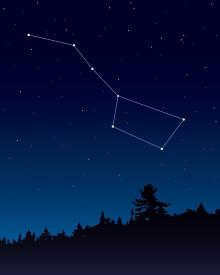
We have been aware of the primary constellations and their names since ancient times. Over the years, this list has been expanded and modified. The comprehensive answer to the question of what constellations are is the list of 88 celestial drawings. The names of these constellations provide insight into when these star patterns were first depicted on star maps. For instance, the majority of mythical characters were illustrious during the era of ancient Greece and Rome. Many of the animals that we are familiar with today, as well as the silhouettes of artistic figures and various instruments, are a result of the reinterpretation of the star chart in the 17th and 18th centuries. Identifying constellations becomes simpler when we associate them with the celestial equator and the poles of the world.
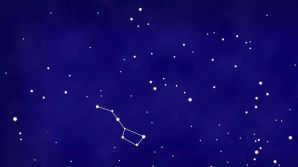
Exciting Space Tales for Middle School Students about the Fascinating World of Constellations
Many centuries ago, people marveled at the magnificent shapes created by the stars in the night sky. These celestial shapes, known as constellations, captivated the imaginations of our ancient ancestors who perceived them as enchanting creatures and legendary figures. Thus, the sky became adorned with the awe-inspiring figures of Orion, Perseus, Hercules, Pegasus, Dragon, and Hydra. The ancient Greeks, in particular, identified and named over 30 remarkable constellations.
Among the constellations, zodiacal constellations hold a special place. These constellations take turns appearing in the sky every month, as the Sun passes through each of them in succession.
While many constellations can only be seen through a telescope, there are 30 that are visible to the naked eye. Some examples include Orion, Pegasus, Cassiopeia, the Ascendant, and the Big Dipper, which covers a large portion of the starry sky in the Northern Hemisphere.
Knowledge of the main constellations is important not only for scientists, but also for sailors, pilots, and travelers. The stars will always guide the way, even in unfamiliar territories.
The constellation “Swan”
The constellation known as “Swan” is also referred to as the Northern Cross. It can be easily located in the summer sky, as its bright stars form an elongated cross over the Milky Way. In ancient times, the Greeks interpreted this constellation as a bird with outstretched wings, specifically a swan (although Arab astronomers believed it resembled a chicken). This celestial Swan appears to “fly” above the Milky Way at the point where it branches into arms.
The primary star of the Swan constellation is called Deneb, which is located at the tail of the Swan. In Arabic, Deneb translates to “bird’s tail.” It is one of the most luminous stars in the entire sky, surpassed in brightness only by a star named Rigel. Deneb shines with the intensity of approximately 6,000 suns combined.
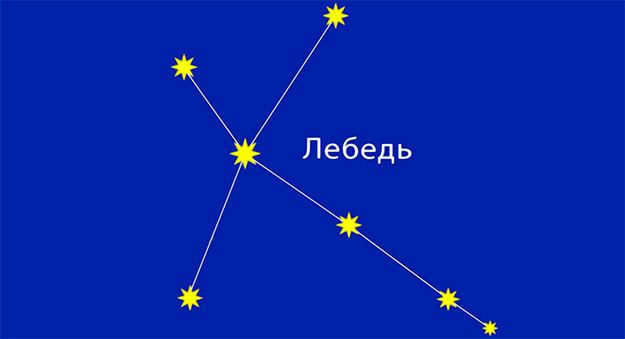
Albireo is the most stunning star located in the Swan constellation. Positioned at the base of the constellation’s cross, this particular star is a vibrant orange color. What makes Albireo even more fascinating is that it is a binary star system, with a brilliant blue companion by its side.
Between these two prominent stars in the Swan constellation, astronomers have discovered the North America Nebula, which strikingly resembles the outline of the continent it is named after.
Notably, one of the stars in the Swan constellation holds significance as it was one of the first stars to have its distance accurately measured. This groundbreaking discovery occurred in 1837, although this star is still identified solely by its serial number – 61.
In 1975, a remarkable event took place in the tail of the Swan constellation. A powerful flash occurred, visible to the naked eye from Earth. For a brief period, a new star illuminated the night sky, but it quickly faded away and is no longer distinguishable among its neighboring stars.
In 1992, a different star had a violent eruption in the Swan constellation. This explosion was also exceptionally luminous. As a result of this sudden burst of light, a small reddish nebula became visible in the tail of the constellation. When the star’s brightness decreased, the nebula would once again fade into obscurity.
The Swan constellation is also renowned for being the location where scientists initially encountered a black hole – a phenomenon that has perplexed researchers for over two centuries.
The constellation Orion
During the autumn and winter seasons, the constellation Orion is easily visible in the night sky. It appears as a large quadrangle shape, seemingly constricted by a belt composed of three brilliant blue-white stars. These stars are significantly hotter and more massive than our Sun. They are equidistant from each other and align in a straight line, creating three rows of three dots. This constellation derives its name from the courageous hunter Orion, a prominent figure in ancient Greek mythology. The most luminous star within Orion is Rigel, which emits a bluish-white hue. Rigel is a genuine supergiant, surpassing the size of our Sun by 40 times and radiating thousands of times more light. It stands out as one of the most radiant celestial objects in the entire night sky.
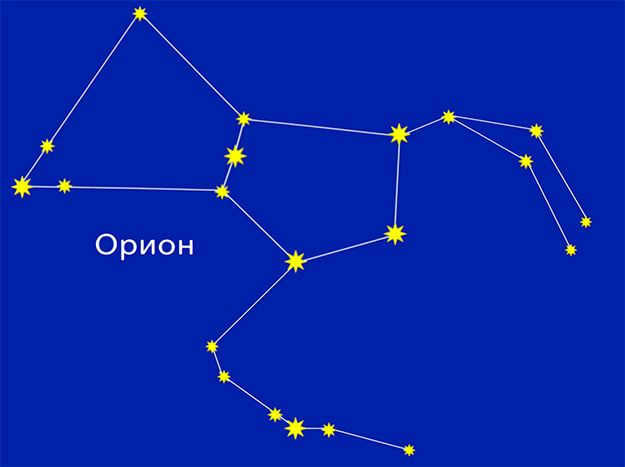
Astronomers have determined that Rigel and Betelgeuse are no older than 10 million years, which is considered young in the vastness of the cosmos. During the time when dinosaurs roamed the Earth, these two stars were not yet visible in the sky.
If you look below Orion’s belt, you will notice a small spot known as the Orion Nebula. Interestingly, this nebula went unnoticed by ancient astronomers and even escaped the attention of Galileo when he observed Orion through his telescope. It was not until 1618 that this nebula was finally discovered. Today, it can be seen with ordinary binoculars.
In the same constellation, there are other nebulae, including the stunning Horsehead Nebula. The presence of multiple nebulae in this region of the Galaxy indicates an ongoing process of star formation.
Every autumn, in the region of Orion, close to the star Betelgeuse, a magnificent display of white shooting stars takes place.
The Canis Major
For centuries, humans have been familiar with the Canis Major constellation. It is often depicted on ancient maps as a loyal dog carrying Sirius, the brightest star in the constellation, in its mouth. Adjacent to Canis Major in the night sky is the mighty Orion, a renowned hunter who is always accompanied by his faithful canine companion. Thus, the ancient civilizations “positioned” Canis Major next to Orion in the celestial realm.
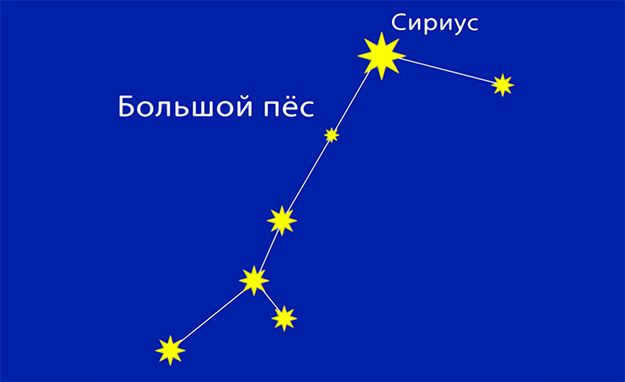
The appearance of Sirius in the summer sky, during the period of scorching heat, was a significant event. During this time, the Romans would avoid working in the fields. The Romans named the star Sirius “Vacation,” referring to it as the “Dog.” Consequently, they also referred to the hottest time of the year as vacations. Interestingly, the Romans were not particularly fond of their vacations. The period when Sirius shone in the sky was considered ominous, as it was believed that dogs would become rabid and people would fall ill with fever.
Sirius can be observed from any part of the Earth, except for the North Pole, making it a star recognized and revered by all ancient civilizations. In Egypt, for instance, temples were strategically constructed to allow the light of Sirius to directly illuminate the altar.
Sirius has a little companion. It’s also referred to as Puppy. It is a compact star that falls into the white dwarf category. Despite being the same size as Earth, it possesses an immense mass. If you were to collect its matter in a matchbox, it would weigh a ton. Remarkably, the African Dogon tribe possessed knowledge of the second star Sirius since ancient times, long before it was officially discovered by European scientists.
Within the constellation known as Big Dog, there exists a distinct pair of stars. These stars are classified as supergiants and are the most massive stars ever observed by astronomers. Each star is nearly 10 million times heavier than Earth. Additionally, they are positioned in close proximity to one another and their gravitational pull is so strong that they have become elongated, resembling two chicken eggs.
The Big Dipper: A Celestial Formation
The Big Dipper, a prominent constellation, dominates the expansive expanse of the northern celestial hemisphere. Comprised of seven distinct stars, this familiar asterism is actually part of a larger constellation that encompasses over 100 stars in total.
The Big Dipper is a unique constellation that never sets below the horizon. It can be observed from any location, and each culture has its own name for this constellation. The Greeks associated it with the nymph Callisto, who was transformed into a bear by the supreme god Zeus and placed in the sky. The Greeks explained the presence of a long tail by saying that Zeus threw the unfortunate bear into the sky, holding her by the tail, causing it to stretch out. Interestingly, the Native Americans also referred to this constellation as Bear. In northern Russia, it was known as Moose. In old Russian, it was called Telega, Wagon, or simply Kovsh. The stars within this Kovsh constellation have their own names, which were coined by ancient Arab astronomers. This is a unique case, as typically only 2-3 of the most prominent stars in a constellation are given names, while the rest are identified by a single letter.
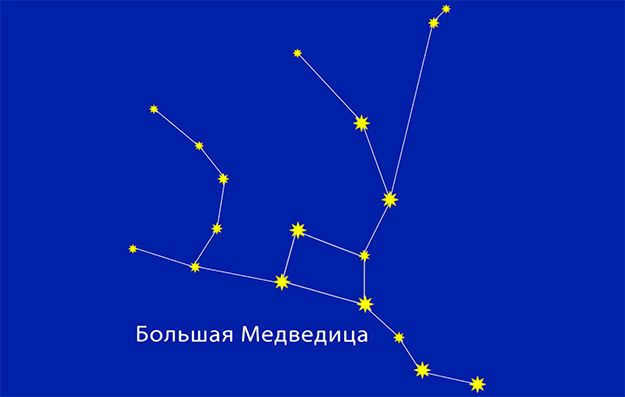
Dubge, also known as the Big Dipper’s main star, is an orange giant that is slightly cooler than the Sun. In Arabic, it means “bear.” Aliot is another bright star in this constellation, shining even brighter than Dubge and serving as a guiding star for centuries. Dubge and Merak, the main stars of the Dipper, are also guiding stars. By mentally drawing a straight line through them, you can locate Polaris.
From ancient times, visual acuity was determined with the help of a small and dim star called Alcor. In ancient Egypt, only those who could recognize this star were accepted into the Pharaoh’s guard. Since there are no bears in Egypt, this constellation was named Hippopotamus.
Within the Big Dipper constellation, astronomers have the opportunity to observe various nebulae and galaxies. One notable feature is the Owl Nebula, which, when viewed through a telescope, appears as the head of a white owl with distinctive black “glasses” surrounding its eyes.
Exploring the “Little Bear” Constellation.
The Little Bear constellation, like the Big Dipper, is considered one of the oldest constellations and has been included in early star catalogs. It remains visible throughout the year and does not go below the horizon. Surrounding the Little Bear is the Dragon constellation.
Positioned directly above the North Pole, the Little Bear constellation features Polaris as its main star. Polaris is located at the outermost point of the “handle” of the dipper and has always served as a guiding star, pointing north. However, in the past, the second star of the Little Bear, known as Kohab, used to shine even brighter. Kohab, meaning “star of the north” in Arabic, has now diminished in brightness over the millennia due to the movement of stars in the sky. As a result, Polaris now shines much brighter for us.
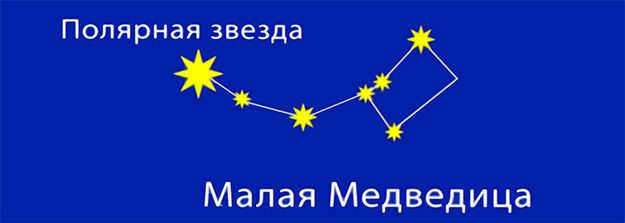
The two prominent stars situated at the bottom of the Small Dipper are referred to as the Protectors of the Pole. They earned this title due to their gradual movement around Polaris, as if they were safeguarding it. Within the constellation of the Small Dipper, adjacent to Polaris, multiple nebulae can be found. Scientists have recently detected a small galaxy in the same constellation, which is actually a satellite of our own Milky Way galaxy.
The Cassiopeia constellation.
Situated above the North Pole, in close proximity to the Big Dipper, the Cassiopeia constellation can be found on the opposite side of Polaris. As Cassiopeia ascends to great heights, the Dipper descends towards the horizon, resulting in a swapping of their positions.
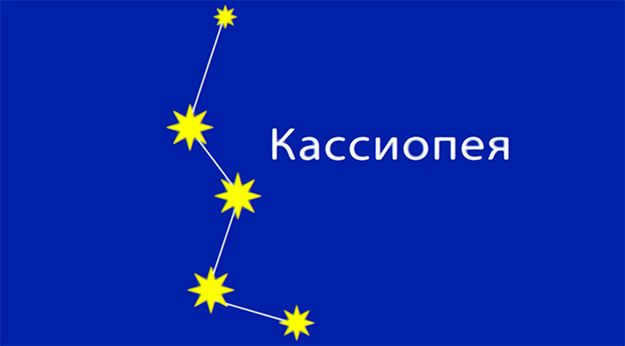
The name of this star formation was given in honor of the Ethiopian queen Cassiopeia. According to the ancient story, she was known for her excessive pride, which angered the gods. As punishment, they bound her to a throne and cast her into the heavens. Now, Cassiopeia revolves around the North Pole, occasionally flipping upside down. This unique behavior is what sets this constellation apart. During the winter months, the prominent stars of Cassiopeia form the shape of the letter “M,” but in the summer, they flip and take the shape of the Latin letter “W.”





